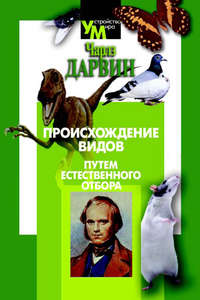 полная версия
полная версияMore Letters of Charles Darwin — Volume 1
I must not indulge {myself} with Cypripedium. Asa Gray has made out pretty clearly that, at least in some cases, the act of fertilisation is effected by small insects being forced to crawl in and out of the flower in a particular direction; and perhaps I am quite wrong that it is ever effected by the proboscis.
I retract so far that if you have the rare C. hirsutissimum, I should very much like to examine a cut single flower; for I saw one at a flower show, and as far as I could see, it seemed widely different from other forms.
P.S. — Answer this, if by chance you can. I remember distinctly having read in some book of travels, I am nearly sure in Australia, an account of the natives, during famines, trying and cooking in all sorts of ways various vegetable productions, and sometimes being injured by them. Can you remember any such account? I want to find it. I thought it was in Sir G. Grey, but it is not. Could it have been in Eyre's book?
LETTER 357. J.D. HOOKER TO CHARLES DARWIN. {November 1862}.
...I have speculated on the probability of there having been a post-Glacial Arctic-Norwego-Greenland in connection, which would account for the strong fact, that temperate Greenland is as Arctic as Arctic Greenland is — a fact, to me, of astounding force. I do confess, that a northern migration would thus fill Greenland as it is filled, in so far as the whole flora (temperate and Arctic) would be Arctic, — but then the same plants should have gone to the other Polar islands, and above all, so many Scandinavian Arctic plants should not be absent in Greenland, still less should whole Natural Orders be absent, and above all the Arctic Leguminosae. It is difficult (as I have told Dawson) to conceive of the force with which arguments drawn from the absence of certain familiar ubiquitous plants strike the botanists. I would not throw over altogether ice-transport and water-transport, but I cannot realise their giving rise to such anomalies, in the distribution, as Greenland presents. So, too, I have always felt the force of your objection, that Greenland should have been depopulated in the Glacial period, but then reflected that vegetation now ascends I forget how high (about 1,000 feet) in Disco, in 70 deg, and that even in a Glacial ocean there may always have been lurking-places for the few hundred plants Greenland now possesses. Supposing Greenland were repeopled from Scandinavia over ocean way, why should Carices be the chief things brought? Why should there have been no Leguminosae brought, no plants but high Arctic? — why no Caltha palustris, which gilds the marshes of Norway and paints the housetops of Iceland? In short, to my eyes, the trans-oceanic migration would no more make such an assemblage than special creations would account for representative species — and no "ingenious wriggling" ever satisfied me that it would. There, then!
I dined with Henry Christy last night, who was just returned from celt hunting with Lartet, amongst the Basques, — they are Pyreneans. Lubbock was there, and told me that my precious speculation was one of Von Baer's, and that the Finns are supposed to have made the Kjokken moddings. I read Max Muller a year ago — and quite agree, first part is excellent; last, on origin of language, fatuous and feeble as a scientific argument.
LETTER 358. TO J.D. HOOKER. Down, November 12th {1862}.
I return by this post Dawson's lecture, which seems to me interesting, but with nothing new. I think he must be rather conceited, with his "If Dr. Hooker had known this and that, he would have said so and so." It seems to me absurd in Dawson assuming that North America was under sea during the whole Glacial period. Certainly Greenland is a most curious and difficult problem. But as for the Leguminosae, the case, my dear fellow, is as plain as a pike-staff, as the seeds are so very quickly killed by the sea-water. Seriously, it would be a curious experiment to try vitality in salt water of the plants which ought to be in Greenland. I forget, however, that it would be impossible, I suppose, to get hardly any except the Caltha, and if ever I stumble on that plant in seed I will try it.
I wish to Heaven some one would examine the rocks near sea-level at the south point of Greenland, and see if they are well scored; that would tell something. But then subsidence might have brought down higher rocks to present sea-level. I am much more willing to admit your Norwego-Greenland connecting land than most other cases, from the nature of the rocks in Spitzbergen and Bear Island. You have broached and thrown a lot of light on a splendid problem, which some day will be solved. It rejoices me to think that, when a boy, I was shown an erratic boulder in Shrewsbury, and was told by a clever old gentleman that till the world's end no one would ever guess how it came there.
It makes me laugh to think of Dr. Dawson's indignation at your sentence about "obliquity of vision." (358/1. See Letter 144.) By Jove, he will try and pitch into you some day. Good night for the present.
To return for a moment to the Glacial period. You might have asked Dawson whether ibex, marmot, etc., etc., were carried from mountain to mountain in Europe on floating ice; and whether musk ox got to England on icebergs? Yet England has subsided, if we trust to the good evidence of shells alone, more during Glacial period than America is known to have done.
For Heaven's sake instil a word of caution into Tyndall's ears. I saw an extract that valleys of Switzerland were wholly due to glaciers. He cannot have reflected on valleys in tropical countries. The grandest valleys I ever saw were in Tahiti. Again, if I understand, he supposes that glaciers wear down whole mountain ranges; thus lower their height, decrease the temperature, and decrease the glaciers themselves. Does he suppose the whole of Scotland thus worn down? Surely he must forget oscillation of level would be more potent one way or another during such enormous lapses of time. It would be hard to believe any mountain range has been so long stationary.
I suppose Lyell's book will soon be out. (358/2. "The Antiquity of Man," 1863.) I was very glad to see in a newspaper that Murray sold 4,000. What a sale!
I am now working on cultivated plants, and rather like my work; but I am horribly afraid I make the rashest remarks on value of differences. I trust to a sort of instinct, and, God knows, can seldom give any reason for my remarks. Lord, in what a medley the origin of cultivated plants is. I have been reading on strawberries, and I can find hardly two botanists agree what are the wild forms; but I pick out of horticultural books here and there queer cases of variation, inheritance, etc., etc.
What a long letter I have scribbled; but you must forgive me, for it is a great pleasure thus talking to you.
Did you ever hear of "Condy's Ozonised Water"? I have been trying it with, I think, extraordinary advantage — to comfort, at least. A teaspoon, in water, three or four times a day. If you meet any poor dyspeptic devil like me, suggest it.
LETTER 359. TO J.D. HOOKER. Down, 26th {March 1863}.
I hope and think you are too severe on Lyell's early chapters. Though so condensed, and not well arranged, they seemed to me to convey with uncommon force the antiquity of man, and that was his object. (359/1. "The Geological Evidences of the Antiquity of Man": London, 1863.) It did not occur to me, but I fear there is some truth in your criticism, that nothing is to be trusted until he {Lyell} had observed it.
I am glad to see you stirred up about tropical plants during Glacial period.
Remember that I have many times sworn to you that they coexisted; so, my dear fellow, you must make them coexist. I do not think that greater coolness in a disturbed condition of things would be required than the zone of the Himalaya, in which you describe some tropical and temperate forms commingling (359/2. "During this {the Glacial period}, the coldest point, the lowlands under the equator, must have been clothed with a mingled tropical and temperate vegetation, like that described by Hooker as growing luxuriantly at the height of from four to five thousand feet on the lower slopes of the Himalaya, but with perhaps a still greater preponderance of temperate forms" ("Origin of Species," Edition VI., page 338).); and as in the lower part of the Cameroons, and as Seemann describes, in low mountains of Panama. It is, as you say, absurd to suppose that such a genus as Dipterocarpus (359/3. Dipterocarpus, a genus of the Dipterocarpaceae, a family of dicotyledonous plants restricted to the tropics of the Old World.) could have been developed since the Glacial era; but do you feel so sure, as to oppose (359/4. The meaning seems to be: "Do you feel so sure that you can bring in opposition a large body of considerations to show, etc.") a large body of considerations on the other side, that this genus could not have been slowly accustomed to a cooler climate? I see Lindley says it has not been brought to England, and so could not have been tried in the greenhouse. Have you materials to show to what little height it ever ascends the mountains of Java or Sumatra? It makes a mighty difference, the whole area being cooled; and the area perhaps not being in all respects, such as dampness, etc., etc., fitted for such temperate plants as could get in. But, anyhow, I am ready to swear again that Dipterocarpus and any other genus you like to name did survive during a cooler period.
About reversion you express just what I mean. I somehow blundered, and mentally took literally that the child inherited from his grandfather. This view of latency collates a lot of facts — secondary sexual characters in each individual; tendency of latent character to appear temporarily in youth; effect of crossing in educing talent, character, etc. When one thinks of a latent character being handed down, hidden for a thousand or ten thousand generations, and then suddenly appearing, one is quite bewildered at the host of characters written in invisible ink on the germ. I have no evidence of the reversion of all characters in a variety. I quite agree to what you say about genius. I told Lyell that passage made me groan.
What a pity about Falconer! (359/5. This refers to Falconer's claim of priority against Lyell. See "Life and Letters," III., page 14; also Letters 166 and 168.) How singular and how lamentable!
Remember orchid pods. I have a passion to grow the seeds (and other motives). I have not a fact to go on, but have a notion (no, I have a firm conviction!) that they are parasitic in early youth on cryptogams! (359/6. In an article on British Epiphytal Orchids ("Gard. Chron." 1884, page 144) Malaxis paludosa is described by F.W. Burbidge as being a true epiphyte on the stems of Sphagnum. Stahl states that the difficulty of cultivating orchids largely depends on their dependence on a mycorhizal fungus, — though he does not apply his view to germination. See Pringsheim's "Jahrbucher," XXXIV., page 581. We are indebted to Sir Joseph Hooker for the reference to Burbidge's paper.) Here is a fool's notion. I have some planted on Sphagnum. Do any tropical lichens or mosses, or European, withstand heat, or grow on any trees in hothouse at Kew? If so, for love of Heaven, favour my madness, and have some scraped off and sent me.
I am like a gambler, and love a wild experiment. It gives me great pleasure to fancy that I see radicles of orchid seed penetrating the Sphagnum. I know I shall not, and therefore shall not be disappointed.
LETTER 360. TO J.D. HOOKER. Down {September 26th 1863}.
...About New Zealand, at last I am coming round, and admit it must have been connected with some terra firma, but I will die rather than admit Australia. How I wish mountains of New Caledonia were well worked!..
LETTER 361. TO J.D. HOOKER.
(361/1. In the earlier part of this letter Mr. Darwin refers to a review on Planchon in the "Nat. History Review," April 1865. There can be no doubt, therefore, that "Thomson's article" must be the review of Jordan's "Diagnoses d'especes nouvelles ou meconnues," etc., in the same number, page 226. It deals with "lumpers" and "splitters," and a possible trinomial nomenclature.)
April 17th {1865}.
I have been very much struck by Thomson's article; it seems to me quite remarkable for its judgment, force, and clearness. It has interested me greatly. I have sometimes loosely speculated on what nomenclature would come to, and concluded that it would be trinomial. What a name a plant will formally bear with the author's name after genus (as some recommend), and after species and subspecies! It really seems one of the greatest questions which can be discussed for systematic Natural History. How impartially Thomson adjusts the claims of "hair-splitters" and "lumpers"! I sincerely hope he will pretty often write reviews or essays. It is an old subject of grief to me, formerly in Geology and of late in Zoology and Botany, that the very best men (excepting those who have to write principles and elements, etc.) read so little, and give up nearly their whole time to original work. I have often thought that science would progress more if there was more reading. How few read any long and laborious papers! The only use of publishing such seems to be as a proof that the author has given time and labour to his work.
LETTER 362. TO J.D. HOOKER. Down, October 22nd and 28th, 1865.
As for the anthropologists being a bete noire to scientific men, I am not surprised, for I have just skimmed through the last "Anthrop. Journal," and it shows, especially the long attack on the British Association, a curious spirit of insolence, conceit, dullness, and vulgarity. I have read with uncommon interest Travers' short paper on the Chatham Islands. (362/1. See Travers, H.H., "Notes on the Chatham Islands," "Linn. Soc. Journ." IX., October 1865. Mr. Travers says he picked up a seed of Edwardsia, evidently washed ashore. The stranded logs indicated a current from New Zealand.) I remember your pitching into me with terrible ferocity because I said I thought the seed of Edwardsia might have been floated from Chili to New Zealand: now what do you say, my young man, to the three young trees of the same size on one spot alone of the island, and with the cast-up pod on the shore? If it were not for those unlucky wingless birds I could believe that the group had been colonised by accidental means; but, as it is, it appears by far to me the best evidence of continental extension ever observed. The distance, I see, is 360 miles. I wish I knew whether the sea was deeper than between New Zealand and Australia. I fear you will not admit such a small accident as the wingless birds having been transported on icebergs. Do suggest, if you have a chance, to any one visiting the Islands again, to look out for erratic boulders there. How curious his statement is about the fruit-trees and bees! (362/2. "Since the importation of bees, European fruit-trees and bushes have produced freely." Travers, "Linn. Soc. Journal," IX., page 144.) I wish I knew whether the clover had spread before the bees were introduced...
I saw in the "Gardeners' Chronicle" the sentence about the "Origin" dying in Germany, but did not know it was by Seemann.
LETTER 363. TO C. LYELL. Down, February 7th {1866}.
I am very much obliged for your note and the extract, which have interested me extremely. I cannot disbelieve for a moment Agassiz on Glacial action after all his experience, as you say, and after that capital book with plates which he early published (363/1. "Etudes sur les Glaciers"; Neuchatel, 1840.); as for his inferences and reasoning on the valley of the Amazon that is quite another question, nor can he have seen all the regions to which Mrs. A. alludes. (363/2. A letter from Mrs. Agassiz to Lady Lyell, which had been forwarded to Mr. Darwin. The same letter was sent also to Sir Charles Bunbury, who, in writing to Lyell on February 3rd, 1866, criticises some of the statements. He speaks of Agassiz's observations on glacial phenomena in Brazil as "very astonishing indeed; so astonishing that I have very great difficulty in believing them. They shake my faith in the glacial system altogether; or perhaps they ought rather to shake the faith in Agassiz...If Brazil was ever covered with glaciers, I can see no reason why the whole earth should not have been so. Perhaps the whole terrestrial globe was once 'one entire and perfect icicle.'" (From the privately printed "Life" of Sir Charles Bunbury, edited by Lady Bunbury, Volume ii., page 334).) Her letter is not very clear to me, and I do not understand what she means by "to a height of more than three thousand feet." There are no erratic boulders (to which I particularly attended) in the low country round Rio. It is possible or even probable that this area may have subsided, for I could detect no evidence of elevation, or any Tertiary formations or volcanic action. The Organ Mountains are from six to seven thousand feet in height; and I am only a little surprised at their bearing the marks of glacial action. For some temperate genera of plants, viz., Vaccinium, Andromeda, Gaultheria, Hypericum, Drosera, Habenaria, inhabit these mountains, and I look at this almost as good evidence of a cold period, as glacial action. That there are not more temperate plants can be accounted for by the isolated position of these mountains. There are no erratic boulders on the Pacific coast north of Chiloe, and but few glaciers in the Cordillera, but it by no means follows, I think, that there may not have been formerly gigantic glaciers on the eastern and more humid side.
In the third edition of "Origin," page 403 (363/3. "Origin," Edition VI., page 335, 1882. "Mr. D. Forbes informs me that he found in various parts of the Cordillera, from lat. 13 deg W. to 30 deg S., at about the height of twelve thousand feet, deeply furrowed rocks...and likewise great masses of detritus, including grooved pebbles. Along this whole space of the Cordillera true glaciers do not now exist, even at much more considerable height. "), you will find a brief allusion, on authority of Mr. D. Forbes, on the former much lower extension of glaciers in the equatorial Cordillera. Pray also look at page 407 at what I say on the nature of tropical vegetation (which I could now much improve) during the Glacial period. (363/4. "During this, the coldest period, the lowlands under the Equator must have been clothed with a mingled tropical and temperate vegetation..." ("Origin," Edition VI., 1882, page 338).)
I feel a strong conviction that soon every one will believe that the whole world was cooler during the Glacial period. Remember Hooker's wonderful case recently discovered of the identity of so many temperate plants on the summit of Fernando Po, and on the mountains of Abyssinia. (363/5. "Dr. Hooker has also lately shown that several of the plants living in the upper parts of the lofty island of Fernando Po, and in the neighbouring Cameroon Mountains, in the Gulf of Guinea, are closely related to those on the mountains of Abyssinia, and likewise to those of temperate Europe" (loc. cit., page 337).) I look at {it} as certain that these plants crossed the whole of Africa from east to west during the same period. I wish I had published a long chapter written in full, and almost ready for the press, on this subject, which I wrote ten years ago. It was impossible in the "Origin" to give a fair abstract.
My health is considerably improved, so that I am able to work nearly two hours a day, and so make some little progress with my everlasting book on domestic varieties. You will have heard of my sister Catherine's easy death last Friday morning. (363/6. Catherine Darwin died in February 1866.) She suffered much, and we all look at her death as a blessing, for there was much fear of prolonged and greater suffering. We are uneasy about Susan, but she has hitherto borne it better than we could have hoped. (363/7. Susan Darwin died in October 1866.)
Remember glacial action of Lebanon when you speak of no glacial action in S. on Himalaya, and in S.E. Australia.
P.S. — I have been very glad to see Sir C. Bunbury's letter. (363/8. The letter from Bunbury to Lyell, already quoted on this subject. Bunbury writes: "There is nothing in the least NORTHERN, nothing that is not characteristically Brazilian, in the flora of the Organ Mountains.") If the genera which I name from Gardner (363/9. "Travels in the Interior of Brazil," by G. Gardner: London, 1846.) are not considered by him as usually temperate forms, I am, of course, silenced; but Hooker looked over the MS. chapter some ten years ago and did not score out my remarks on them, and he is generally ready enough to pitch into my ignorance and snub me, as I often deserve. My wonder was how any, ever so few, temperate forms reached the mountains of Brazil; and I supposed they travelled by the rather high land and ranges (name forgotten) which stretch from the Cordillera towards Brazil. Cordillera genera of plants have also, somehow, reached the Silla of Caracas. When I think of the vegetation of New Zealand and west coast of South America, where glaciers now descend to or very near to the sea, I feel it rash to conclude that all tropical forms would be destroyed by a considerably cooler period under the Equator.
LETTER 364. TO C. LYELL. Down, Thursday, February 15th {1866}.
Many thanks for Hooker's letter; it is a real pleasure to me to read his letters; they are always written with such spirit. I quite agree that Agassiz could never mistake weathered blocks and glacial action; though the mistake has, I know, been made in two or three quarters of the world. I have often fought with Hooker about the physicists putting their veto on the world having been cooler; it seems to me as irrational as if, when geologists first brought forward some evidence of elevation and subsidence, a former Hooker had declared that this could not possibly be admitted until geologists could explain what made the earth rise and fall. It seems that I erred greatly about some of the plants on the Organ Mountains. (364/1. "On the Organ Mountains of Brazil some few temperate European, some Antarctic, and some Andean genera were found by Gardner, which did not exist in the low intervening hot countries" ("Origin," Edition VI., page 336).) But I am very glad to hear about Fuchsia, etc. I cannot make out what Hooker does believe; he seems to admit the former cooler climate, and almost in the same breath to spurn the idea. To retort Hooker's words, "it is inexplicable to me" how he can compare the transport of seeds from the Andes to the Organ Mountains with that from a continent to an island. Not to mention the much greater distance, there are no currents of water from one to the other; and what on earth should make a bird fly that distance without resting many times? I do not at all suppose that nearly all tropical forms were exterminated during the cool period; but in somewhat depopulated areas, into which there could be no migration, probably many closely allied species will have been formed since this period. Hooker's paper in the "Natural History Review" (364/2. Possibly an unsigned article, entitled "New Colonial Floras" (a review of Grisebach's "Flora of the British West Indian Islands" and Thwaites' "Enumeratio Plantarum Zeylaniae"). — "Nat. Hist. Review," January 1865, page 46. See Letter 184.) is well worth studying; but I cannot remember that he gives good grounds for his conviction that certain orders of plants could not withstand a rather cooler climate, even if it came on most gradually. We have only just learnt under how cool a temperature several tropical orchids can flourish. I clearly saw Hooker's difficulty about the preservation of tropical forms during the cool period, and tried my best to retain one spot after another as a hothouse for their preservation; but it would not hold good, and it was a mere piece of truckling on my part when I suggested that longitudinal belts of the world were cooled one after the other. I shall very much like to see Agassiz's letter, whenever you receive one. I have written a long letter; but a squabble with or about Hooker always does me a world of good, and we have been at it many a long year. I cannot understand whether he attacks me as a wriggler or a hammerer, but I am very sure that a deal of wriggling has to be done.









